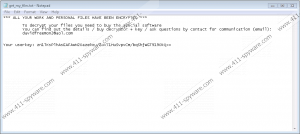David Ransomware Removal Guide
Losing your priceless vacation pictures or MS Office documents before you can blink is possible once the PC is infected with ransomware. The David ransomware is one of the threats that can destroy your file for good if you do not have them backed up on a separate storage device. The infection gets on the computer unnoticed and encrypts files using an AES encryption algorithm. This is done to take your data hostage and demand a ransom, which is not specified in the ransom warning of the infection. Ransomware is now at its peak and widespread as never before, so you should not delay removing the David ransomware and taking measures to prevent similar incidents in the future.
Like many other damaging threats, the David threats encrypts files and appends its extension to every encrypted file. The threat adds the extension .david; hence the name of the infection. However, some malware researchers may argue about the name of this piece of malware because of the origin of the threat. The David ransomware is a new variant of Velso, another ransomware infection which is installed on the victimized computer after getting access to it through remove access services.
The David ransomware corrupts a great variety of files in different formats, including the Firefox and Chrome browsers; only the Internet Explorer browser is left intact, which is probably done so that the victim could use the browser to contact the criminal for more information about file decryption and payment.
Unlike many ransomware threats, the David ransomware does not specify the ransom fee. The infection creates the file get_my_files.txt in every directory, and the ransom warning in the file instructs the victim to send an email to davidfreemon2@aol.com for more details.
Additionally, the ransom note does not mention the currency of the ransom. In most cases, the Bitcoin currency is required by ransomware authors, but some recent detections suggest that schemers might soon shift to more predictable crypto currencies in terms of their rates, and which are also less expensive than the well-known Bitcoin currency.
Law enforcement agencies advise victims against paying up just because the possibility of regaining access to the lost data is extremely low. Ransomware authors are not known to help their victims after money submission, which only proves that there is no need to spend a considerable sum of money for the service you are not going to get in return.
Ransomware has already caused enormous financial damage to hundreds of businesses, a great part of which paid up in the hope of regaining their databases and files. Paying a ransom encourages current cyber criminals to continue working on their nefarious ransomware projects and also inspires other criminals to get involved in this field of the dark market. Do not become a statistic. Do not pay any ransom payments, but take preventative measures in advance of the malware attack.
For example, a large and valuable amount of data should be stored in a cloud backup or portable storage devices. In case of a cloud, the copies should not be connected to the same network in any way; otherwise, the backed up data could be lost in the event of a ransomware attack. Moreover, it is important to be critical to unexpected emails received from well-know companies. For example, if you receive an invoice even though you have not purchased anything lately, the email is most likely a phishing scam. Downloading a file attachment or clicking a link within the deceitful email might cause some damage, which you can prevent by simply paying attention to details. If you use the RDP service, the password and the user name should be strong enough for the attackers not to break them down. Needless to say, it is important to have an anti-malware program running on the PC at all times.
Below you will a brief removal guide for deleting the malicious files of the David ransomware, which can also be removed by anti-malware. We recommend implementing a reputable malware prevention tool to have the David ransomware removed and the system shielded from malware, which accesses the computer unnoticed in most of the cases. If you have any questions concerning the removal of this threat, feel free to leave a comment below so that our team could help you.
How to remove the David Ransomware
- Check the desktop form malicious files. Delete questionable recently downloaded files.
- If no malicious files are present on the desktop, access the Downloads folder or other folder to which you save downloaded files. Delete questionable executable files.
- Remove the ransom note files of the infection.
David Ransomware Screenshots:

David Ransomware technical info for manual removal:
Files Modified/Created on the system:
| # | File Name | File Size (Bytes) | File Hash |
|---|---|---|---|
| 1 | get_my_files.txt | 367 bytes | MD5: 619a0aed5474564fa2d3da64f8d9510d |
| 2 | David Ransom.exe | 830464 bytes | MD5: a499a1d530c8f034ecf7ce009377f92f |
Memory Processes Created:
| # | Process Name | Process Filename | Main module size |
|---|---|---|---|
| 1 | David Ransom.exe | David Ransom.exe | 830464 bytes |

